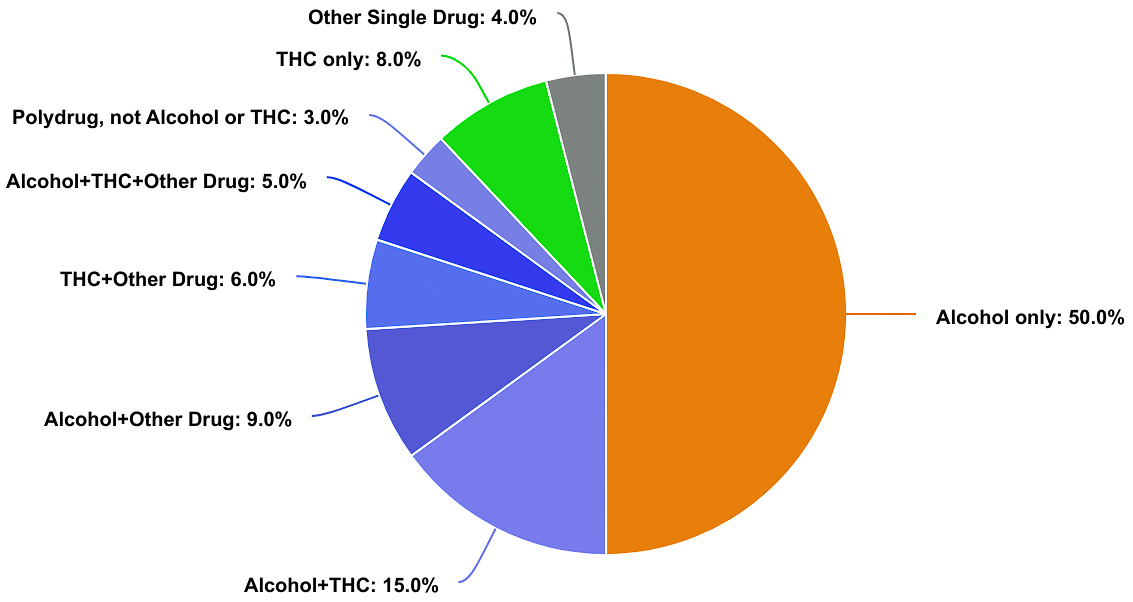
Estimated causes of DUI cases from Colorado’s Office of Research and Statistics, Department of Public Safety
Sources:
Which substances cause impaired driving? It turns out we cannot know that answer precisely. However, we now have sufficient data to reasonably estimate that about half of Colorado’s 2020 impaired driving cases were due to alcohol only, while the other half were drug related. See the basis for this estimate below.
Polydrug impairment (impairment caused by two or more psychoactive drugs) was the primary drug related cause (38%) of impaired driving, followed by marijuana’s THC at 8%. Although THC was the most common impairing drug (34%) after alcohol found in DUI samples, three-fourths of THC cases were polydrug users who included THC in their impairing cocktail.
Over 50 impairing drugs were found in drivers’ blood samples. After alcohol and THC, the most common “other” drugs were methamphetamine, amphetamine, cocaine, benzodiazepines, and opioids. The most rapidly increasing drug frequency was fentanyl, increasing from 6 cases in 2016 to 151 in 2020. Although nearly all “other” drugs are prescription drugs, they also are widely abused “street” drugs. We have no means to determine how many of the “other drug” cases were intentional drug abusers versus users following doctors’ prescriptions. For example, the most widely found benzodiazepine found in DUI case filings was alprazolam which is also the most widely prescribed psychotropic medication in the United States. XanexTM is one of over 20 brand names for alprazolam.
Basis for the statement that half of DUI cases are drug related
Colorado links the data bases of toxicology laboratories and the courts to produce a report to show the causes and judicial consequences of DUI arrests. These reports, unique to Colorado, are produced pursuant to C.R.S ¶24-33.5-520 by the Office of Research and Statistics, Department of Criminal Justice, Division of Public Safety. The reports have been remarkably helpful to improve understanding of the causes and judicial consequences of driving under the influence but reports are limited by the data available. The analysis herein is based on the report released in 2023 that covers data for 2020.
Most drivers arrested for impaired driving are tested only for alcohol since that is faster and cheaper than testing for other drugs. If alcohol is present, there is usually no reason to perform testing for drugs other than alcohol, so we have no information about use of other impairing drugs in those cases. Additionally, many drivers refuse to comply with “expressed consent” or “implied consent” laws that require drivers arrested for impairment to provide a biological sample for testing.
For example, in 2018 Colorado tested 51% of DUI defendants for alcohol only but just 7% for both alcohol and drugs. The remaining 42% refused to comply with the expressed consent law.
But in 2020, many Colorado law enforcement agencies relied more on blood testing than on breath testing of those arrested for DUI. This was done to avoid potential transmission of COVID 19 from the use of evidentiary breath testing devices that are routinely used to detect alcohol impairment. Therefore, the frequency of alcohol only testing was more than halved in 2020 while the number of subjects who received comprehensive drug testing was five times higher than it was two years earlier. This provided a rich data set to estimate the causes of impaired driving in Colorado. Of the 21,066 impaired driving case filings in 2020, 37% had comprehensive drug testing, and 22% were tested only for alcohol. The remainder had no toxicology testing submitted. No other state has reported a higher percentage of comprehensive drug testing of impaired driving suspects than Colorado’s 37% in 2020.
Of the cases that were comprehensively drug tested, 35% were due to alcohol only. But that number is biased towards drug cases since historically, comprehensive testing was reserved for cases where the arresting officer suspected drugs other than alcohol. When cases tested for alcohol only are added to those comprehensively tested, we find that 60% of the cases receiving any kind of toxicology testing were due to alcohol only. But that number is biased in the other direction towards alcohol only cases because an unknown number of alcohol only positive cases were actually undetected polydrug cases. The best we can do with the data we have is to estimate that somewhere between 35% and 60% were due to alcohol only, hence our estimate of about half.
